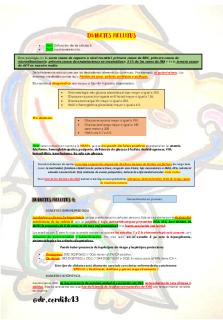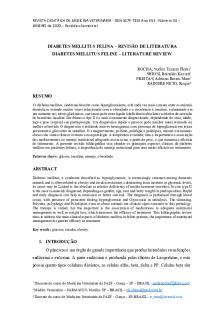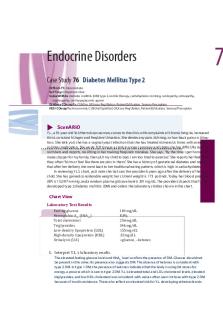Diabetes Mellitus Case Study PDF

| Title | Diabetes Mellitus Case Study |
|---|---|
| Author | Anonymous Helper |
| Course | Medsurg 1 |
| Institution | South University |
| Pages | 15 |
| File Size | 475 KB |
| File Type | |
| Total Downloads | 27 |
| Total Views | 191 |
Summary
Download Diabetes Mellitus Case Study PDF
Description
Diabetes Mellitus Type I/DKA UNFOLDING Reasoning
Jack Anderson, 9 years old
Concept Glucose Regulation
Primary
Interrelated Concepts (In order of emphasis)
• • • • • •
Fluid and Electrolyte Balance Acid-Base Balance Clinical Judgment Patient Education Communication Collaboration
NCLEX Client Need Categories
Percentage of Items from Each Category /Subcategory
Covered in Case Study
Safe and Effective Care Environment Management of Care Safety and Infection Control Health Promotion and Maintenance
17-23% 9-15% 6-12%
0 2020 KeithRN LLC. All rights reserved. No part of this case study may be reproduced, stored in retrieval system or transmitted in any form or by any means, electronic, mechanical, photocopying, recording or otherwise, without the prior written permission of KeithRN
6-12%
Psychosocial Integrity Physiological Integrity Basic Care and Comfort
6-12%
Pharmacological and Parenteral Therapies
12-18%
Reduction of Risk Potential
9-15%
Physiological Adaptation
11-17%
History of Present Problem: Jack Anderson is a 9-year-old boy who presents to the emergency department because he has been more sleepy and his breathing is "not normal;" it is deeper and faster, according to his parents. Jack was sick with a respiratory virus two weeks ago but has since recovered. Jack began feeling more tired a few days ago when he started to complain of abdominal pain, headache, muscle aches, and consistently being hungry and thirsty. He is urinating more frequently during the day and at night. His mother reports a normal full-term pregnancy and Jack has been healthy with no known medical conditions.
Personal/Social History: Jack lives with both parents and two siblings; a younger sister four years old and a 12-year-old brother. Both parents work as middle school teachers in the community. Jack is in the 4th grade and earns above-average marks. He is physically active and plays soccer on the school team.
What data from the histories are RELEVANT and must be interpreted as clinically significant by the nurse? NCSBN: Ste 1 Recognize cues/NCLEX Reduction of Risk Potential Reduction of Risk Potential
RELEVANT Data from Present Problem: -
-
He’s more sleepy His breathing is “not normal” it’s deeper and faster Was sick with a respiratory virus 2 weeks ago Always hungry and thirsty
RELEVANT Data from Social History: -
Clinical Significance:
-
Fatigue is a common symptom and can result from high blood sugar levels Kussmaul breathing is rapid or labored breathing, a symptom of DKA Lack of insulin or insulin resistance helping convert food to energy causes increased hunger and thirst
Clinical Significance:
Physically active and plays soccer on the school team
-
He is active and getting the needed exercise
Patient Care Begins: Current VS:
P- -R-S-T Pain Assessment:
T: 100.4 F/38.0 C (oral) P: 136 (regular) R: 44 (deep/rapid) BP: 80/48
Provoking/Palliative: Quality: Region/Radiation: Severity
Made worse with solid food. Dull and aching Confined to abdomen, generalized within abdominal region He states his pain is a 4/10 on the numeric scale.
0 2020 KeithRN LLC. All rights reserved. No part of this case study may be reproduced, stored in retrieval system or transmitted in any form or by any means, electronic, mechanical, photocopying, recording or otherwise, without the prior written permission of KeithRN
02 sat: 98% on RA Weight: 64.0 lbs/29.1 kg
Timing
States, "All the time"
What VS data are RELEVANT and must be interpreted as clinically significant by the nurse? NCSBN: Ste I Recognize cues/NCLEX Reduction of Risk Potential Reduction of Risk Potential/Health Promotion and Maintenance
RELEVANT VS Data: - Temperature - Pulse - Respirations - Blood pressure
Clinical Significance: - High temp. could be a sign of infection - Tachycardia - Kussmaul respirations - Very low blood pressure, could be a sign of dehydration with the excessive urination
Current Assessment: GENERAL SURVEY: NEUROLOGICAL:
HEENT:
RESPIRATORY: CARDIAC:
ABDOMEN: GU: INTEGUMENTARY:
Lying on the bed with eyes closed, whimpers with touch, recognizes mom and dad. Fruity odor to the breath. Lethargic, responding to parents with one-word phrases. Alert & oriented to person, place, time, and situation (x4); muscle strength 5/5 in both upper and lower extremities bilaterally Head normocephalic with symmetry of all facial features. PERRLA, sclera white bilaterally, conjunctival sac pink bilaterally. Eyes appear "sunken," mucus membranes, tac mucosa, chapped lips. Breath sounds clear with equal aeration on inspiration and expiration in all lobes anteriorly, posteriorly, and laterally, respirations are deep and rapid Pink, warm & dry, no edema, heart sounds regular, pulses slightly weak/thready, equal with palpation at radial/pedal/post-tibial landmarks, cap refill 2 seconds. Heart tones audible and regular, Sl and S2, noted over A-P-T-M cardiac landmarks with no abnormal beats or murmurs. Abdomen round, soft, and tender to light palpation. BS active in all four quadrants, feeling nauseated Voiding large amounts of clear light-yellow urine Skin warm, dry, itchy, flushed, intact, normal color for ethnicity. No clubbing of nails, cap refill 5.5 mmol/L This value is critically high with symptoms of irregular heartbeat and slow, weak, or even absent pulse - Monitor cardiac rhythms - Insulin
Lab: Normal Value: Clinical Significance: Nursing Assessments/lnterventions Required:
Glucose Value:
680 Critical Value: >200
This value is high also. With symptoms of frequent urination, fatigue, increased thirst. -
IV fluids Monitor glucose levels
Clinical Reasoning Begins...
0 2020 KeithRN LLC. All rights reserved. No part of this case study may be reproduced, stored in retrieval system or transmitted in any form or by any means, electronic, mechanical, photocopying, recording or otherwise, without the prior written permission of KeithRN
1. Interpreting relevant clinical data, what is the primary problem(s)? What primary health-related concepts does this primary problem represent? (NCSBN: Step 2 Analyze cues/NCSBN: Step 3 Prioritize hypotheses Management of Care/Ph siolo ic Ada tation
Problem(s): Pathophysiology of Problem in OWN Words:
Primary Concept:
DKA with new The body has an insulin deficiency causing high levels of glucose. The lack of insulin in the body is causing the body to metabolize fats and proteins for energy. onset of diabetes This starts the form ketones. mellitus type 1
2. Is this patient at risk for a change in status that could lead to an adverse outcome due to age, susceptible host, or other factors? (NCSBN: Step 2 Analyze cues/Management of Care) Risk Factors for Rationale: Developing Complication: -
Age
-
His smaller body increases the risk almost complete volume depletion due to the dehydration
3. What is the worst possible/most likely complication(s) to anticipate based on the primary problem of this patient? NCSBN: Ste 2 Anal ze cues/Reduction o Risk Potential/Ph siolo ic Ad tation
Worst Possible/Most Likely
Complication to Anticipate: Nursing Interventions to PREVENT this Complication: -
Monitor vital signs Monitor lab values
- Cerebral edema - Hypokalemia - Kidney damage
Assessments to Identify Problem EARLY: -
Test blood sugar levels Blood test to test electrolytes (serum electrolyte)
Nursing Interventions to Rescue: -
Notify provider
0 2020 KeithRN LLC. All rights reserved. No part of this case study may be reproduced, stored in retrieval system or transmitted in any form or by any means, electronic, mechanical, photocopying, recording or otherwise, without the prior written permission of KeithRN
Collaborative Care: Medical Management 4. State the rationale and expected outcomes or the medical plan of care. (Pharm. and Parenteral Therapies) Care Provider Orders:
Rationale:
Establish two large bore peripheral IVs
-
Admit to the Pediatric ICU
-
NPO
Vital signs every 30 minutes with neurological checks every hour Continuous cardiac monitor STAT finger stick for blood glucose then every one hour
-
Getting as much fluid in the patient as possible Nurses and doctor specialize in pediatric care Stabilizes blood glucose Vitals and neuro checks can present early signs of any changes Monitor for any dysrhythmias caused by the increased potassium levels Need to check blood glucose ASAP for levels Need to rehydrate the patient Insulin is needed to regulate the blood glucose levels
Expected Outcome: -
-
-
-
Administer NS 20mL/kg1V BOLUS
(over one hour) then begin h NS with 20 mEq KCL at maintenance rate (1 , 000 mL for first 10 kg + 500 mL for next 10 kg over 24 hours) After fluid bolus start IV Regular insulin infusion at 0.05 unit/kg/hour Once blood glucose level is less than 300 mg/dL or the blood glucose fall is more than 100 mg/dL, change IV fluids above to Dextrose 5% in 0.45 NaCl
-
IV in place Healthcare team can monitor closely Blood glucose stabilizes Vitals and neuro checks will be normal Will have normal sinus rhythms during the monitoring Levels within normal limits Levels that are high or low will be brought back to normal due to the
0 2020 KeithRN LLC. All rights reserved. No part of this case study may be reproduced, stored in retrieval system or transmitted in any form or by any means, electronic, mechanical, photocopying, recording or otherwise, without the prior written permission of KeithRN
-
with 20 mEq KCL
-
Strict I &O and daily weight
-
Ondansetron 2 mg/mL IV push prn every 4 hours nausea
Daily weight monitors any changes that could be caused Ondansetron helps with nausea Acetaminophen helps with the abdomen pain
-
Acetaminophen suppository per rectum 350 mg PRN every 4 hours comfort or temp > 38.5 C (>101.3 F)
rehydration The blood glucose won’t get too low
Weight will be stable Patient will experience no nausea Patients abdomen pain will subside
PRIORITY Setting: 5. Which Orders DO You Implement First and Why? (Management of Care) Care Provider Orders:
• Obtain finger stick blood
Order of Priority: -
glucose
• Start IV insulin after bolus is given and monitor blood glucose carefully
• Obtain VS • Accurate I and O • Place cardiac monitor • Initiate two large bore IVs and administer fluid bolus followed by maintenance/replacement
-
-
Initiate two large bore IVs and administer fluid bolus followed by maintenance/replacemen t Obtain finger stick blood glucose Obtain VS Place on a cardiac monitor Start IV insulin after bolus is given and monitor blood glucose carefully Accurate I and O
Rationale: -
Have to correct the dehydration Monitor the blood glucose levels Monitor vitals and making sure they are within normal limits Monitor for any dysrhythmias caused by the increased potassium levels Monitor to make sure the insulin is effective Making sure there are no changes from the fluid being pumped in the body
0 2020 KeithRN LLC. All rights reserved. No part of this case study may be reproduced, stored in retrieval system or transmitted in any form or by any means, electronic, mechanical, photocopying, recording or otherwise, without the prior written permission of KeithRN
Collaborative Care: Nursing 6. What nursing priority (ies) will guide your plan of care? (NCSBN: Step 4 Generate solutions/Step 5: Take action Management of Care
Nursing PRIORITY: PRIORITY Nursing Interventions: -
Initiate two large bore IVs and administer fluid bolus followed by maintenance/replacement
Rationale: -
Expected Outcome:
IV fluid will correct the dehydration
-
Patient will be rehydrated
7. What body system(s) will you assess most thoroughly based on the primary/priority concern? Reduction o Risk Potential/Physiologic Adaptation
PRIORITY Body System:
PRIORITY Nursing Assessments: -
- Cardio - Neuro - Renal
Heart rate and blood pressure LOC and breathing patterns I&O and daily weights
8. What psychosocial/holistic care PRIORITIES need to be addressed for this patient? Ps chosocial Inte ri /Basic Care and Com ort
Psychosocial PRIORITIES:
PRIORITY Nursing Interventions:
Rationale:
Expected Outcome:
0 2020 KeithRN LLC. All rights reserved. No part of this case study may be reproduced, stored in retrieval system or transmitted in any form or by any means, electronic, mechanical, photocopying, recording or otherwise, without the prior written permission of KeithRN
CARE/COMFORT:
EMOTIONAL (How to develop a therapeutic relationship):
Dosage Calculations
• • • •
Weight 64 lbs. Convert to kg:
29.1kg
Administer 0.9% NS 20 mL/kg bolus over one hour. Calculate IV bolus:
582mL
Administer regular insulin infusion at 0.05 units/kg/hour. Calculate units/hour:
1.45 units/hr.
Regular insulin IV is 250 units/250 mL 0.9% NS. Calculate hourly IV drip rate:
1.45 mL/hr.
Evaluation: Four hours later... Evaluate the response of your patient to nursing and medical interventions during your shift. All physician orders have been implemented that are listed under medical management. Jack has been transferred from the ED to pediatric ICU two hours ago. His blood glucose is now 442 (this is an appropriate value based on the average of 50-75 mg/dL/hour correction). His insulin gtt is infusing at 1.5 units/hour. You just collected the following clinical data: Admission 4 hours: Current VS: Current RST: T: 98.9 F/37.2C oral
T: 100.4 F/38.0 C (oral)
Provoking/Palliative:
P: 92 re
P: 136 (regular)
R: 24 (reg)
R: 44 (deep/rapid)
Region/Radiation:
BP: 100/60 02 sat: 98% on RA
BP: 80/48 02 sat: 98% on RA
Severity: Timing:
Quality:
Dull and aching Confined to abdomen, generalized within abdominal re •on 2/10 numeric scale States "All the time"
Blood Glucose: 442 Current Assessment:
0 2020 KeithRN LLC. All rights reserved. No part of this case study may be reproduced, stored in retrieval system or transmitted in any form or by any means, electronic, mechanical, photocopying, recording or otherwise, without the prior written permission of KeithRN
GENERAL SURVEY: NEUROLOGICAL: HEENT:
Pleasant, in no acute distress, calm, body relaxed, no grimacing, appears to be resting comfortably Alert & oriented to person, place, time, and situation (x4); muscle strength 5/5 in both u r and lower extremities bilaterally Head normocephalic with symmetry of all facial features. PERRLA, sclera white bilaterally, conjunctival sac pink bilaterally. Lips, tongue, and oral mucosa pink and moist.
RESPIRATORY:
Breath sounds clear with equal aeration on inspiration and expiration in all lobes anteriorly, posteriorly, and laterally, nonlabored respiratory effort on room air. CARDIAC: Pink, warm & dry, no edema, heart sounds regular, pulses strong, equal with palpation at radial/pedal/post-tibial landmarks, brisk cap refill. Heart tones audible and regular, SI and S2 noted over A-P-T-M cardiac landmarks with no abnormal beats or murmurs. ABDOMEN: Abdomen round, soft, and nontender. BS active in all 4 quadrants GU: Voiding without difficult urine clear/ yellow INTEGUMENTARY: Skin warm, dry, intact, normal color for ethnicity. No clubbing of nails, cap refill...
Similar Free PDFs

Diabetes Mellitus Case Study
- 15 Pages

Diabetes Mellitus Case Study v1
- 3 Pages

Diabetes mellitus
- 15 Pages

Diabetes Mellitus
- 3 Pages

Diagnosis Diabetes Mellitus
- 4 Pages

Pathway of Diabetes Mellitus
- 4 Pages

makalah diabetes mellitus
- 10 Pages

DIABETES MELLITUS RESÚMEN CLAVE
- 3 Pages

PAE diabetes mellitus
- 16 Pages

Diabetes Mellitus em gatos
- 8 Pages

Ensayo diabetes mellitus
- 3 Pages
Popular Institutions
- Tinajero National High School - Annex
- Politeknik Caltex Riau
- Yokohama City University
- SGT University
- University of Al-Qadisiyah
- Divine Word College of Vigan
- Techniek College Rotterdam
- Universidade de Santiago
- Universiti Teknologi MARA Cawangan Johor Kampus Pasir Gudang
- Poltekkes Kemenkes Yogyakarta
- Baguio City National High School
- Colegio san marcos
- preparatoria uno
- Centro de Bachillerato Tecnológico Industrial y de Servicios No. 107
- Dalian Maritime University
- Quang Trung Secondary School
- Colegio Tecnológico en Informática
- Corporación Regional de Educación Superior
- Grupo CEDVA
- Dar Al Uloom University
- Centro de Estudios Preuniversitarios de la Universidad Nacional de Ingeniería
- 上智大学
- Aakash International School, Nuna Majara
- San Felipe Neri Catholic School
- Kang Chiao International School - New Taipei City
- Misamis Occidental National High School
- Institución Educativa Escuela Normal Juan Ladrilleros
- Kolehiyo ng Pantukan
- Batanes State College
- Instituto Continental
- Sekolah Menengah Kejuruan Kesehatan Kaltara (Tarakan)
- Colegio de La Inmaculada Concepcion - Cebu




